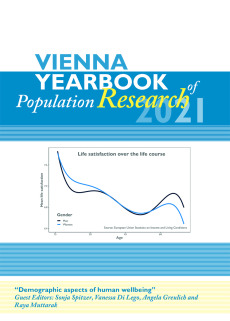Vienna Yearbook of Population Research / Vienna Yearbook of Population Research, 2021, Vol. 19
Demographic aspects of human wellbeing. Guest Editors: Sonja Spitzer, Vanessa Di Lego, Angela Greulich and Raya Muttarak
Gastherausgeber: Vanessa Di Lego, Bandherausgeber: Angela Greulich, Gastherausgeber: Raya Muttarak, Gastherausgeber: Sonja Spitzer, Reihe herausgegeben von Institut für Demographie der Österreichischen Akademie der Wissenschaften, Herausgegeben von Tomáš Sobotka
Serie: Vienna Yearbook of Population ResearchThe Vienna Yearbook of Population Research is an open access journal that features contributions addressing population trends as well as a broad range of theoretical and methodological issues in population research. Besides Research articles and Review articles, the journal includes Data and Trends contributions, which analyse changes in population dynamics or present databases and data infrastructure. The journal also publishes Debates – invited short contributions and reflections on selected questions and issues. Since 2008, the volumes have been devoted to selected themes following special calls for thematic issues.
The 2021 special issue explores demographic perspectives on human wellbeing across time and space. While the idea of relating demographic parameters to wellbeing has been around for a while, a more concrete research agenda on the topic has gained momentum only recently. This volume gives an overview on the latest developments and shows how existing theoretical concepts and methodological tools in demography offer substantial advancements for the study of wellbeing. A large part of the volume is devoted to the challenges of defining and measuring wellbeing, with the most important debate being on whether the focus should be on objective measures like income or subjective definitions of wellbeing such as happiness. The various authors define wellbeing as health and mortality, as income, education or other resources, as happiness or life satisfaction, or a combination thereof, by introducing novel composite indicators. The volume covers wellbeing in historical and contemporary populations, in high- and low-income countries all around the world, also pointing at important research hindrances due to the lack of good-quality data in many regions. Most empirical contributions consider population heterogeneity to study how wellbeing differs by population subgroups and whether some demographic and socioeconomic groups fall behind, thereby providing important policy implications.

